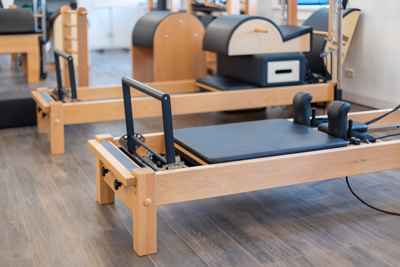Are Reformer Classes Safe?

The true benefits of the Pilates Method lie in its value as preventative exercise. It takes a significant time to learn how to teach it well and requires continuing professional development post qualification. It is a holistic method of exercise that helps restore the overall balance and freedom of movement of the human body, not just a series of exercises to make you look good. The Reformer is only one part of a range of equipment used during a Pilates Studio class.
It is possible to do a whole class on the Reformer alone, but to do that the individual needs to already have a well-developed awareness and understanding of how the movements weave together from the inside out, in coherence with the nature of the human body. The exercises on the Reformer, however, are part of a whole body of work that connect together in a cohesive, developmental way. It is not a piece of gym equipment.
It is worth noting that vocational Pilates training programmes, provided by well-established professional organisations, take at least 12 months, and usually more. A good training includes functional anatomy and physiology. It requires working alongside an experienced teacher to learn hands-on support and guidance and how to adapt or modify the exercises and the equipment for individual needs. The training will also include learning a tailored approach for injury rehabilitation, post-surgery or during pregnancy. It is a fulsome, vocational training with assessments and a qualification at the end of it.
What people are saying about Reformer classes
Newspapers and magazines are telling us that many celebrities are now attending Reformer classes to help them stay fit and toned. From what was described in a recent article I read in the Style section of the Evening Standard on 14th March 2024, it’s clearly the latest discovery of the fitness industry as another way to help them make a significant amount of money. I have been told that their staff are given a couple of days’ training to learn the exercises on the Reformer and they are then expected to teach up to 20 people at the same time. In this short time frame it would be impossible for the instructors to be taught how to modify the exercises for individual needs, let alone learn the developmental pathway through the wide range of movements on the Reformer that support the restoration of musculoskeletal function.
People attending Reformer classes might feel like they’re getting a good ‘workout’ and they may well see changes in their muscle tone too. From my lifetime experience with this work, however, it is much more likely that their functional patterns will be reinforced rather than re-educated. Without good tuition from a well-trained teacher, this can eventually lead to back, shoulder, neck, hip, knee or ankle problems rather than preventing them. The restoration of postural muscle balance takes time and it certainly doesn’t start with using heavy springs on the Reformer.
All of the apparatus used in a Pilates studio are precision pieces of engineering that require a depth of understanding on how to utilise them safely and effectively and anyone using this equipment should be made aware of that fact. Reformer classes are potentially dangerous in the hands of someone who has had a short period of training and there have already been documented cases of injuries in these classes. Understanding how to work with the extending and rebounding action of those strong springs is much more than just pushing against the bar at the end of the carriage.
As someone who has taught Pilates for over 40 years now, I was very saddened to read the article, “Why we’re obsessed with reformer Pilates” in the Evening Standard and many clients contacted me to comment on it too. This latest exercise fad of putting Reformers into health clubs and gyms as a stand-alone piece of equipment for a group class is counter to the real genius of the Pilates Method and an anathema to our profession.
What is essential for choosing a Reformer Class?
If you do go to a Reformer class, please be aware that there is much more to Pilates than the Reformer on its own and check that the best practice guidelines for a safe Reformer class are being implemented:
- There should be no more than 5 people in a class so the teacher is able to support and help each person at their stage of learning and with exercises appropriate to their physical capacity.
- Do not assume whoever is instructing the class is qualified. Check that they are a fully trained Pilates teacher and that they have trained in the whole body of this technique, not just on the Reformer.
- Be bold and ask your instructor how long they trained for and whether they do Pilates apparatus classes as ongoing professional development themselves.
- And if they tell you to attach all of the springs the first time you do a class with them, leave immediately. The springs are heavy and you can easily get hurt.
Should I buy my own Reformer?
As for buying a Reformer to have in your home - the article I read said, “think Pelaton”. Unless you are a trained Pilates teacher already or are training to teach Pilates with a well-established training organisation, be very cautious about buying one. They are expensive and you cannot learn how to use this piece of Pilates apparatus from a video alone. Use the money instead to get a good teacher to guide you so you can experience the full benefit of what this extraordinary method of holistic exercise can actually give you. The true benefits of the Pilates Method is a lifetime journey of deep inquiry to discover the fluidity and profound nature of how your body moves and ensures that you can keep moving well to the end of your days.
Hana Jones
Pilates Foundation Professional Standards Advisor

